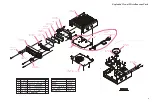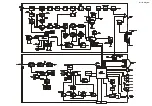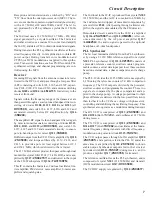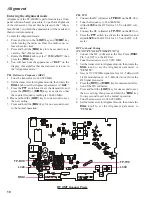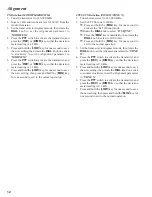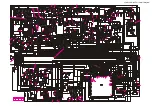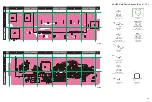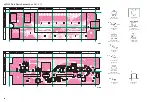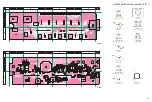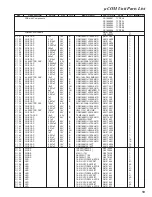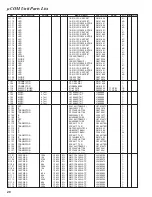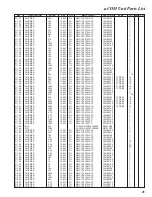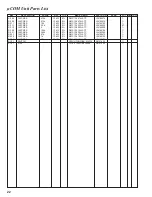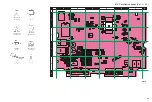
9
Alignment
Introduction and Precautions
The FT-2800M has been carefully aligned at the factory
for the specified performance at the 144 MHz amateur
band. Realignment should therefore not be necessary ex-
cept in the event of a component failure. All component
replacement and service should be performed only by an
authorized Vertex Standard representative, or the warranty
policy may be voided.
The following procedures cover the sometimes critical and
tedious adjustments that are not normally required once
the transceiver has left the factory. However, if damage
occurs and some parts are replaced, realignment may be
required. If a sudden problem occurs during normal oper-
ation, it is likely due to component failure; realignment
should not be done until after the faulty component has
been replaced.
We recommend that servicing be performed only by au-
thorized Vertex Standard service technicians who are ex-
perienced with the circuitry and fully equipped for repair
and alignment. Therefore, if a fault is suspected, contact
the dealer from whom the transceiver was purchased for
instructions regarding repair. Authorized Vertex Standard
service technicians realign all circuits and make complete
performance checks to ensure compliance with factory
specifications after replacing any faulty components.
Those who do undertake any of the following alignments
are cautioned to proceed at their own risk. Problems caused
by unauthorized attempts at realignment are not covered
by the warranty policy. Also, Vertex Standard must re-
serve the right to change circuits and alignment proce-
dures in the interest of improved performance, without
notifying owners.
Under no circumstances should any alignment be attempt-
ed unless the normal function and operation of the trans-
ceiver are clearly understood, the cause of the malfunc-
tion has been clearly pinpointed and any faulty compo-
nents replaced, and the need for realignment determined
to be absolutely necessary.
Required Test Equipment
The following test equipment (and thorough familiarity
with its correct use) is necessary for complete realign-
ment. Correction of problems caused by misalignment
resulting from use of improper test equipment is not cov-
ered under the warranty policy. While most steps do not
require all of the equipment listed, the interactions of some
adjustments may require that more complex adjustments
be performed afterwards. Do not attempt to perform only
a single step unless it is clearly isolated electrically from
all other steps. Have all test equipment ready before be-
ginning, and follow all of the steps in a section in the
order presented.
Regulated DC Power Supply: adjustable from 10 to 17
VDC, 15 A
RF Signal Generator with calibrated output level at
200 MHz
Frequency Counter: ±0.1 ppm accuracy at 200 MHz
AF Signal Generator
SINAD Meter
Deviation Meter (linear detector)
AF Milivoltmeter
AF Dummy Load: 8-Ohm, 5 W
DC Voltmeter: high impedance
Inline Wattmeter with 5% accuracy at 200 MHz
50-Ohm non-reactive Dummy Load:
100 watts at 200 MHz
VHF Sampling Coupler
Set up the test equipment as shown for the transceiver
alignment, and apply 13.8 VDC power to the transceiver.
Alignment Preparation & Precautions
A dummy load and inline wattmeter must be connected to
the antenna jack in all procedures that call for transmis-
sion, except where specified otherwise. Correct alignment
is not possible with an antenna. After completing one step,
read the following step to determine whether the same
test equipment will be required. If not, remove the test
equipment (except dummy load and wattmeter, if connect-
ed) before proceeding.
Correct alignment requires that the ambient temperature
in the repair shop be the same as that of the transceiver
and test equipment, and that this temperature be held con-
stant between 68 °C and 86 °F (20 °C ~ 30 °C). When the
transceiver is brought into the shop from hot or cold air it
should be allowed some time for thermal equalization with
the environment before alignment. If possible, alignments
should be made with oscillator shields and circuit boards
firmly affixed in place. Also, the test equipment must be
thoroughly warmed up before beginning.
Notes
: Signal levels in dB referred to in alignment are
based on 0 dB
μ
= 0.5
μ
V.
Summary of Contents for FT-2800M
Page 4: ...4 Exploded View Miscellaneous Parts Note...
Page 5: ...Block Diagram...
Page 6: ...Block Diagram Note...
Page 13: ...COM Unit RF Unit Circuit Diagram...
Page 14: ...COM Unit RF Unit Circuit Diagram Note...
Page 18: ...18 Note...
Page 24: ...24 a b c d e f g 1 2 3 4 5 Side B 1SS312 D302 311 RF Unit Parts Layout Lot 1 15...
Page 28: ...28 a b c d e f g 1 2 3 4 5 Side B 1SS312 D302 311 RF Unit Parts Layout Lot 57...
Page 38: ...38 REF DESCRIPTION VALUE V W TOL MFR S DESIG VXSTD P N VERS LOT SIDE LAY ADR Note...
Page 39: ...13...



